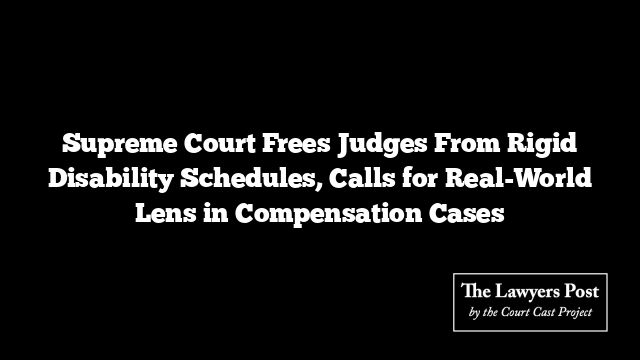In a powerful shift toward realism over rigid rules, the Supreme Court has ruled that when determining compensation for functional disability, courts are not shackled to the strict percentages listed in the Employees’ Compensation Act, 1923. Justice Sudhanshu Dhulia and Justice K. Vinod Chandran led the bench that brought a more human-centered approach to the forefront.
The case concerned a worker who, back in 2002, operated a forging machine for a modest ₹2,500 a month. His life took a brutal turn in 2004 when an accident at work cost him large parts of four fingers on his right hand. After surgery, the Commissioner ruled he had suffered 100% disability, awarding him ₹3,20,355 along with 12% interest and a 50% penalty on the delayed employer payment.
However, when the employer appealed, the Bombay High Court slashed the disability figure down to just 34%, sticking religiously to the old schedule laid out in the Employees’ Compensation Act. They also noted the absence of a medical certificate and insisted that disability must align with what’s specified on paper, not in the worker’s lived experience.
The Supreme Court wasn’t buying it.
Drawing heavily from the landmark Oriental Insurance Co. Ltd. v. Mohd. Nasir, the bench reminded everyone that both the Employees’ Compensation Act and the Motor Vehicles Act were created to offer quick, fair relief to accident victims — and must be interpreted with compassion, not cold bureaucracy. The precedent made it clear: functional disability — the real-world harm to a person’s ability to live and earn — can’t be captured by checklists and technicalities alone.
The Court pointed out that while the Schedule under the 1923 Act correlates permanent disability with functional disability in some cases, it’s a legal fiction, not a medical certainty. They stressed that judges must look beyond schedules when reality demands it — especially when multiple injuries aren’t neatly categorized by law.
In this worker’s case, the Schedule didn’t even contemplate the loss of two-and-a-half phalanges of an index finger. Using a broader, fairer lens, the Court assessed his functional disability at 50%, reasoning that the damage to his dominant hand had deeply crippled his ability to grip and work — far more devastating than the High Court’s 34% figure suggested.
Ultimately, the Court recalculated the compensation: ₹3,20,355, with half assessed as loss (₹1,60,177.5), 12% interest from the date of the accident, and a 50% penalty (₹80,088.75). If the High Court’s ordered payment had already been made, the difference must be settled, again with interest and penalty.
The message from the Supreme Court was unmistakable: Real life isn’t lived in schedules, and justice shouldn’t be either.





